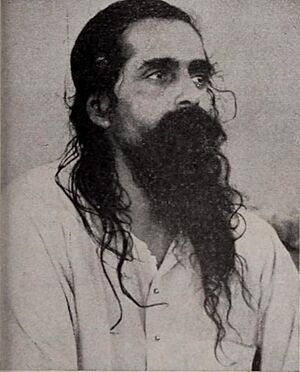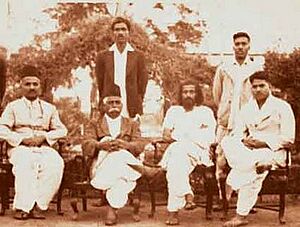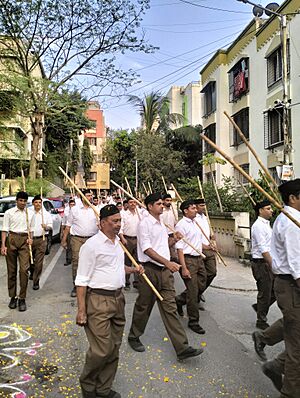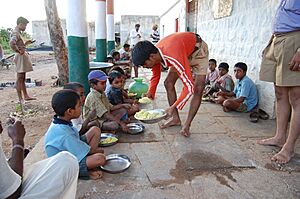Rashtriya Swayamsevak Sangh facts for kids
Quick facts for kids Rashtriya Swayamsevak Sangh |
|
|---|---|

The saffron flag (Bhagwa Dhwaj), an official symbol of the RSS
|
|
| Also known as | RSS |
| Leaders | Mohan Bhagwat (Sarsanghchalak) Dattatreya Hosabale (Sarkaryavah) |
| Foundation | 27 September 1925 |
| Country | |
| Motives | Promotion of Hindutva and Hindu nationalism |
| Headquarters | Dr. Hedgewar Bhawan, Sangh Building Road, Nagpur, Maharashtra – 440 032, India |
| Ideology | Hindutva Hindu nationalism |
| Political position | Right-wing |
| Status | Active |
| Size |
|
| Part of | Sangh Parivar |
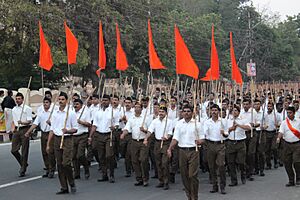
The Rashtriya Swayamsevak Sangh (RSS) is a large volunteer group in India. Its name means "National Volunteer Union" or "National Volunteer Corps." It is a right-wing organization that promotes an idea called Hindutva. The RSS is the main group in a larger family of organizations called the Sangh Parivar. This family includes the Bharatiya Janata Party (BJP), which is the current ruling political party in India. Mohan Bhagwat has been the chief leader, called Sarsanghchalak, of the RSS since March 2009.
The RSS was started on September 27, 1925. Its first goal was to teach good character and "Hindu discipline." This was meant to bring the Hindu community together and create a Hindu Rashtra (Hindu nation). The group wants to spread the idea of Hindutva to make the Hindu community stronger. It also promotes the idea of upholding Indian culture and its traditional values. The RSS has faced criticism for being intolerant towards minority groups, especially regarding activities against Muslims.
During the time when India was ruled by the British, the RSS did not join the Indian independence movement. After India became independent, the RSS grew into a powerful Hindu nationalist group. It created many other organizations, including schools, charities, and clubs, to share its ideas. The Indian government has banned the RSS three times. The first ban was in 1948, after Nathuram Godse, a former member of the RSS, assassinated Mahatma Gandhi. It was banned again during the Emergency (1975–1977) and a third time after the demolition of Babri Masjid in 1992. Today, the RSS is considered one of the world's largest right-wing organizations. Some people have criticized the RSS as an extremist group, saying it promotes hatred and violence.
Contents
Founding the RSS
The RSS was started in 1925 by K. B. Hedgewar. He was a doctor in the city of Nagpur, which was part of British India at the time.
Hedgewar was inspired by B. S. Moonje, a politician and social activist. Hedgewar also learned about secret revolutionary groups in Calcutta. He used some of their methods to organize the RSS. After reading a book called Hindutva by V. D. Savarkar, Hedgewar was greatly influenced. He founded the RSS to make Hindu society stronger.
Hedgewar believed that the British could rule India because Hindus were not united and lacked courage. He recruited young Hindu men and gave them a uniform. They wore a black cap, white shirt, and khaki shorts. He taught them paramilitary skills using a bamboo staff (lathi), sword, and other tools. Hindu ceremonies and rituals were important in the organization. They helped members feel connected to India's past and to each other. The saffron flag of the warrior king Shivaji, called the Bhagwa Dhwaj, became the symbol of the RSS. Early activities included protecting Hindu pilgrims at festivals.
In 1927, Hedgewar started an "Officers' Training Camp." This was to create a group of dedicated full-time workers called pracharaks. These pracharaks were asked to give up their jobs and family lives to work for the RSS. Hedgewar wanted them to be like "sadhus" (holy people). The main goal for Hedgewar was to create a network of shakhas (branches) across India. The first pracharaks helped set up these branches, first in Nagpur, then across Maharashtra, and eventually in other parts of India. They also targeted universities to recruit students.
Why the RSS Was Formed
Experts have different ideas about why Hedgewar started the RSS. One reason is that he never involved the RSS in the movement to gain independence from British rule. French political scientist Christophe Jaffrelot says the RSS aimed to spread the idea of Hindutva. It also wanted to give "new physical strength" to the Hindu community.
After a leader named Tilak passed away in 1920, Hedgewar and others in Nagpur disagreed with some of Mahatma Gandhi's plans. They were concerned about Gandhi's support for the Muslim Khilafat Movement. They also felt that protecting cows was not a priority for the Indian National Congress. Because of these differences, Hedgewar and his group separated from Gandhi's approach. In 1921, Hedgewar was arrested for his speeches and spent a year in prison.
After his release in 1922, Hedgewar was worried about the lack of organization among volunteer groups. He felt it was important to create a new group based on India's traditions. He met with important political figures in Nagpur. He also visited Gandhi's ashram in 1924. After this, he planned to unite different Hindu groups into one nationalist movement.
Hindu and Muslim Relations
The 1920s saw a difficult time between Hindus and Muslims. The Khilafat movement involved many Muslims. They were upset about the breakup of the Ottoman Empire and wanted the Caliphate in Turkey to be restored. Mahatma Gandhi worked with this movement to support his own Non-co-operation movement. Gandhi hoped to create Hindu–Muslim unity. However, some Muslims later turned their anger towards Hindus.
One major event was the Moplah rebellion in August 1921. It was reported that this rebellion led to violence against Hindu officials. This started a cycle of violence between communities across India for several years. In 1923, there were riots in Nagpur. Hedgewar called them "Muslim riots" and felt that Hindus were "totally disorganized." These events made a strong impression on Hedgewar. They convinced him that Hindu society needed to be organized.
In 1927, after the RSS had about 100 volunteers, Hedgewar took action. He led a Hindu religious procession for Ganesha. They played drums even though it was not common to pass a mosque with music. On September 4, Muslims reportedly reacted. When the Hindu procession reached a mosque in Nagpur, Muslims blocked it. Later, they attacked Hindu homes. It is said that RSS members were ready and fought back. Riots continued for three days, and the army had to step in. The RSS organized Hindu resistance and protected Hindu homes. This event greatly increased the RSS's reputation and helped it grow.
Hindu Mahasabha's Influence
The Hindu Mahasabha was an important influence on the RSS. In 1923, Hindu leaders met and talked about divisions in the Hindu community. A leader named Madan Mohan Malaviya said that friendship could only exist between equals. He wanted activists to educate children, set up gyms, and create volunteer groups. He also wanted them to accept untouchables as Hindus. Later, V. D. Savarkar's ideas about 'Hindutva' also greatly influenced Hedgewar's thoughts on the 'Hindu nation'.
The first meeting to form the RSS in 1925 included Hedgewar and four Hindu Mahasabha leaders. The RSS also helped organize the Hindu Mahasabha's annual meeting in 1931. Many leaders from the Hindu Mahasabha helped the RSS grow. Officials even called the RSS the "volunteer organization of the Hindu Mahasabha."
History of the RSS
Indian Independence Movement
From its beginning, the RSS chose not to join the Indian independence movement against British rule. The RSS saw itself as a social movement. Hedgewar kept the organization from directly joining political groups fighting the British. The RSS disagreed with Gandhi's willingness to work with Muslims.
The RSS carefully avoided any political actions that could be seen as anti-British. According to an RSS writer, Hedgewar only talked about Hindu organizations and avoided commenting directly on the government. The RSS celebrated "Independence Day" in 1930, but then stopped doing so. They also did not use the Tricolor flag of the Indian national movement. Hedgewar personally joined Gandhi's Salt Satyagraha in April 1930, but he made sure the RSS as a group did not participate. He told everyone that the RSS would not join the Satyagraha. However, individuals could participate if they wished.
M. S. Golwalkar, who became the RSS leader in 1940, continued this approach. He believed the RSS should achieve freedom by "defending religion and culture," not by fighting the British. Golwalkar did not want the British to ban the RSS. He followed all government rules during World War II. The British government believed the RSS was not supporting any protests against them. A report from the Bombay government noted that the RSS had always followed the law. It also said that the RSS had promised not to do anything the British government considered wrong.
Golwalkar later admitted that the RSS did not join the Quit India Movement. He also said the RSS did not support the Royal Indian Navy mutiny against the British in 1946. Overall, the RSS did not join the independence movement. Instead, it focused on working with the British government.
Partition of India
The Partition of India in 1947 caused great violence and displacement for millions of Sikhs, Hindus, and Muslims. During this time, the RSS helped Hindu refugees fleeing West Punjab. Some RSS members also took part in the violence during Hindu-Muslim riots in North India. However, the RSS leadership officially did not approve of this. Many RSS members felt that the partition happened because of a soft approach towards Muslims. They blamed Gandhi, Nehru, and Patel for the partition and the mass killings.
First Ban on the RSS
The RSS was first banned in Punjab Province (British India) on January 24, 1947. This ban was put in place by the premier of the Unionist Party. The ban was lifted just four days later, on January 28, 1947.
Views on the National Flag of India
The RSS initially did not accept the Tricolor as the National Flag of India. An RSS publication, the Organiser, asked for the Bhagwa Dhwaj (saffron flag) to be the national flag. After the Tricolor was chosen as the National Flag in July 1947, the Organiser strongly criticized this decision. It said that a flag with three colors would have a "very bad psychological effect."
In his book Bunch of Thoughts, Golwalkar also expressed sadness about the choice of the Tricolor. He felt that India, with its long history, should have had its own traditional flag. The RSS raised the National Flag of India at its Nagpur headquarters only twice: on August 14, 1947, and January 26, 1950. After that, they stopped. This became a source of debate. In 2001, some activists reportedly raised the national flag by force at the RSS headquarters on Republic Day. They said the RSS had never raised the Tricolor there before. The activists were arrested but later released. In 2002, after new flag rules were made, the National Flag was raised at the RSS headquarters on Republic Day for the first time in 52 years.
Views on the Constitution of India
The RSS initially did not accept the Constitution of India. They criticized it because it did not mention "Manu's laws" from the ancient Hindu text Manusmriti. In November 1949, the RSS newspaper, the Organiser, complained that the Constitution had "no mention of that unique constitutional development in ancient Bharat." It said that Manu's laws still "excite the admiration of the world."
In February 1950, the Organiser published another article supporting the Manusmriti as the main law for Hindus. It said that Hindus still follow its principles. The RSS continued to criticize the Constitution after independence. In 1966, Golwalkar wrote that India's Constitution was just a mix of ideas from Western countries. He felt it had nothing truly Indian.
Second Ban on the RSS
India's first prime minister, Jawaharlal Nehru, was cautious about the RSS. After Gandhi's assassination, Golwalkar asked Nehru to lift the ban on the RSS. Nehru replied that the government had proof that RSS activities were "anti-national" because they were "communalist." He wrote that the RSS was like a "private army" following "Nazi lines."
In January 1948, Mahatma Gandhi was assassinated by Nathuram Godse, a former member of the RSS. After this, many RSS leaders were arrested, and the RSS was banned on February 4, 1948. During the court case, Godse claimed he had left the RSS in 1946. A commission later found that the RSS *as an organization* was not responsible for Gandhi's murder. However, the Home Minister, Sardar Vallabhbhai Patel, said that RSS members had "expressed joy and distributed sweets" after Gandhi's death. This event made the RSS very unpopular.
After his release in August 1948, Golwalkar asked Nehru to lift the ban. Patel, the Home Minister, said the RSS needed to adopt a formal written constitution. He wanted the RSS to promise loyalty to the Constitution of India, accept the Tricolor as the National Flag of India, and be more democratic. Golwalkar protested this, and was imprisoned again. Later, a constitution was written for the RSS. It was changed to meet most of Patel's demands.
Patel initially said in January 1948 that RSS members were "patriots." He asked Congress members to "win over" the RSS. However, after Gandhi's assassination, Patel saw the RSS's activities as a danger. He wrote to Golwalkar that while the RSS helped Hindus during the partition violence, they also attacked Muslims. He said RSS speeches were "full of communal poison," which led to Gandhi's death. Patel was also concerned about the RSS's secrecy and its own "army" within India. He said, "Hinduism would not be saved by rowdyism."
On July 11, 1949, the Indian government lifted the ban on the RSS. This happened after Golwalkar promised that the RSS would be loyal to the Constitution and respect the National Flag.
Taking Back Dadra and Nagar Haveli
After India became independent, the RSS supported efforts to free Dadra and Nagar Haveli from Portuguese rule. In 1954, RSS volunteers visited the area to learn about it and meet locals who wanted to join India. In April 1954, the RSS joined with other groups to take over Dadra and Nagar Haveli. On July 21, 1954, one group captured a Portuguese police station and declared Dadra independent. Then, on July 28, RSS volunteers and others captured more areas, including the capital of Silvassa. The Portuguese forces surrendered on August 11, 1954.
This event boosted the movement against Portuguese rule in India. In 1955, RSS leaders demanded an end to Portuguese rule in Goa. When Prime Minister Jawaharlal Nehru did not send armed forces, RSS leader Jagannath Rao Joshi led a peaceful protest into Goa. He and his followers were arrested. On August 15, 1955, Portuguese police fired on protesters, killing about thirty civilians.
The Emergency Period
In 1975, the government led by Indira Gandhi declared emergency rule in India. This limited freedoms, including freedom of the press. The Emergency was declared after a leader named Jayaprakash Narayan asked people to protest the government. Many opposition leaders were arrested. The RSS, known for its large organization, was seen as capable of organizing protests. So, it was also banned.
Deoras, the RSS chief at the time, wrote to Indira Gandhi. He promised the RSS's help if the ban was lifted. He said the RSS was not involved in the protests. He also tried to get others to help mediate between the RSS and the government. Some RSS members claim they continued their activities secretly during the Emergency.
The Emergency ended in 1977, and the ban on the RSS was lifted. This period is said to have made the RSS more accepted in Indian politics.
How the RSS is Organized
The RSS does not have a formal membership process. According to its website, men and boys can become members by joining the nearest shakha, which is their basic unit.
Although the RSS says it doesn't keep membership records, it was estimated to have between 2.5 and 6 million members in 2001.
Leaders and Members
Here are some terms for RSS leaders and members:
- Sarsanghchalak: This is the head of the RSS. The previous head chooses the next one.
- Sarkaryavah: This is like a general secretary or executive head. Dattatreya Hosabale is the Sarkaryavah as of 2021.
- Sah-Sarkaryavah: These are joint general secretaries. There are usually four of them.
- Vicharak: These are RSS leaders who serve as thinkers or ideologues for the organization.
- Pracharak: These are active, full-time missionaries who spread RSS ideas. They are very important to the organization. Many pracharaks dedicate their lives to the RSS. Two well-known former pracharaks are former prime minister Atal Bihari Vajpayee and current Prime Minister of India, Narendra Modi.
- Karyakarta: These are active workers. To become a karyakarta, members go through four levels of training. Most karyakartas are "householders" who support the organization part-time. About 5% are pracharaks who work full-time.
- Mukhya-Shikshak: This is the head teacher and chief of a shakha.
- Karyawah: This is the executive head of a shakha.
- Gatanayak: This is a group leader.
- Swayamsevak: This means "volunteer." They attend the shakhas of the RSS.
Shakhas (Branches)
The word shakha means "branch" in Hindi. Most of the RSS's work happens through its many shakhas. These shakhas meet for one hour in public places. The number of shakhas has changed over time. In 1975, there were 8,500. By 1982, there were 20,000. In 2004, there were over 51,000 shakhas across India. The number dropped after the BJP government lost power in 2004. However, by mid-2014, it increased again to about 40,000 after the BJP returned to power. In August 2015, there were 51,335 shakhas.
Shakhas offer various activities for volunteers. These include physical fitness through yoga, exercises, and games. They also have activities that promote civic awareness, social service, community living, and patriotism. Volunteers learn first aid and how to help in rescue operations. They are also encouraged to get involved in community development.
Most shakhas are in Hindi-speaking regions. As of 2016, Delhi had 1,898 shakhas. Uttar Pradesh had over 8,000, Kerala had 6,845, and Maharashtra had 4,000. In northeast India, there are over 1,000 shakhas. As of late 2015, Bihar had 1,421 shakhas, Rajasthan had 4,870, and Tamil Nadu had 2,060.
According to the RSS Annual Report of 2019, there were a total of 84,877 shakhas. Of these, 59,266 met daily.
Uniform
In October 2016, the RSS changed its uniform. For 91 years, members wore khaki shorts. Now, they wear dark brown trousers with a white button-up shirt and a black sidecap.
Anthem
The song Namastē Sadāvatsale Matrubhoomē is the anthem or prayer of the RSS. It is a salute to the motherland.
Groups Connected to the RSS
Organizations that share the RSS's ideas are called members of the Sangh Parivar (Sangh family). Often, pracharaks (full-time RSS volunteers) helped start and manage these groups.
Some of these connected organizations include:
- Bharatiya Janata Party (BJP): This is a major political party in India.
- Vishwa Hindu Parishad: This means "World Hindu Council."
- Akhil Bharatiya Vidyarthi Parishad: This is a large student organization.
- Vidya Bharati: This is a network of schools.
- Bharatiya Kisan Sangh: This means "Indian Farmers' Association."
- Bharatiya Mazdoor Sangh: This means "Indian Labour Association."
- Seva Bharti: This group focuses on helping those in need.
- Rashtra Sevika Samiti: This is a volunteer association for women.
- Hindu Swayamsevak Sangh: This is a Hindu volunteer association.
- Vishwa Samvad Kendra: This is the communication wing for media work.
- Vivekananda Kendra: This group promotes the ideas of Swami Vivekananda.
While the RSS generally supports the BJP, it has sometimes chosen not to if there are disagreements.
RSS Beliefs
Views on Non-Hindu Communities
The RSS has faced criticism regarding its views on non-Hindu religions. Some of its past leaders, like Golwalkar, expressed strong views on minorities. While the RSS has been accused of intolerance, it also has Muslim and Christian members. According to the RSS, Indian Muslims and Christians are descendants of Hindus who changed their faith. They can be members if they agree with the RSS's beliefs. They are still asked to attend shakhas and recite Hindu hymns. The Muslim Rashtriya Manch is a group for Muslim members connected to the RSS.
In January 2020, the RSS and other groups protested against installing a statue of Jesus at Kapala Hills. This land was given to the Christian community by the government.
Attitude Towards Jews
Before World War II, some RSS leaders were said to admire certain European political figures. However, the RSS's stance changed during the war. The organization supported the British against Hitler. RSS leaders also supported the creation of the Jewish State of Israel. Golwalkar admired Jewish people for keeping their "religion, culture and language."
Helping the Community
Helping with Land Reforms
RSS volunteers took part in the Bhoodan movement. This movement, led by Vinobha Bhave, encouraged land reform through voluntary donations. Golwalkar was inspired by this idea and promised the RSS's support. Many RSS volunteers, led by Nanaji Deshmukh, joined the movement.
Changes in the Caste System
The RSS has supported training Dalits and other backward classes to become temple priests. Traditionally, this role was only for Caste Brahmins. The RSS believes that the caste system divides society. They think that including lower castes in this way will help strengthen Hindu values. The RSS has also criticized upper-caste Hindus for stopping Dalits from entering temples. They say that "even God will desert the temple in which Dalits cannot enter."
While some experts suggest that early RSS leaders were mostly Brahmins, others say that members from all castes have always been welcomed and treated equally. In 1934, Mahatma Gandhi visited an RSS camp. He said he was "very much surprised by your discipline and absence of untouchability." He found that volunteers lived and ate together without caring about each other's castes.
Relief and Support Work

The RSS has played a big role in helping people after natural disasters. They helped after the 1971 Odisha cyclone, the 1977 Andhra Pradesh cyclone, and the 1984 Bhopal disaster. They also helped after the 2001 Gujarat earthquake, rebuilding villages. About 35,000 RSS members helped in these efforts.
An RSS-linked charity, Seva Bharati, helped after the 2004 Indian Ocean earthquake and tsunami. They built shelters and provided food, clothes, and medical supplies. Seva Bharati also adopted 57 children (38 Muslims and 19 Hindus) from conflict areas in Jammu and Kashmir to provide them education. They also cared for victims of the Kargil War in 1999.
During the 1984 anti-Sikh riots, some RSS activists protected and helped members of the Sikh community.
In 2006, the RSS helped people in Surat, Gujarat, who were affected by floods. They provided food, milk, and water. RSS volunteers also helped after floods in North Karnataka and parts of Andhra Pradesh in 2009. In 2013, after the Uttarakhand floods, RSS volunteers helped with relief work.
During the 2020 coronavirus lockdown in India, the RSS provided important services. They gave out masks, soap, and food across India. In 2020, a Muslim woman from Jammu and Kashmir donated her savings for a Hajj pilgrimage to the RSS-affiliated 'Sewa Bharati'. She was impressed by their welfare work during the lockdown. The number of Muslim students in schools run by Vidya Bharati, the RSS's education group, increased by about 30% in Uttar Pradesh between 2017 and 2020.
Sports Activities
In 1992, the RSS started the Kreeda Bharati sports organization in Pune. Kreeda Bharati promotes traditional Indian sports, rural games, and other established sports.
Images for kids
See also
 In Spanish: Rastriya Swayamsevak Sangh para niños
In Spanish: Rastriya Swayamsevak Sangh para niños
- Rashtra Sevika Samiti
- Hindu Swayamsevak Sangh
- Rashtriya Sikh Sangat



